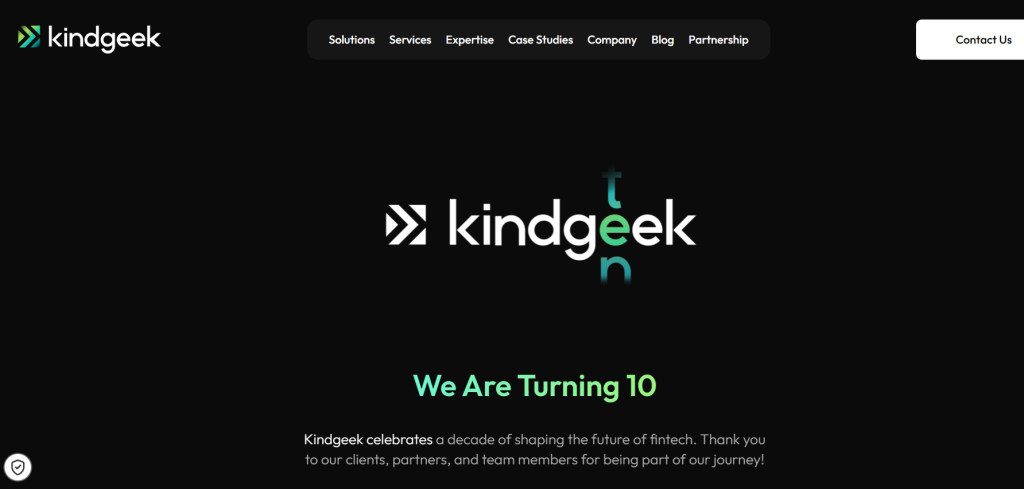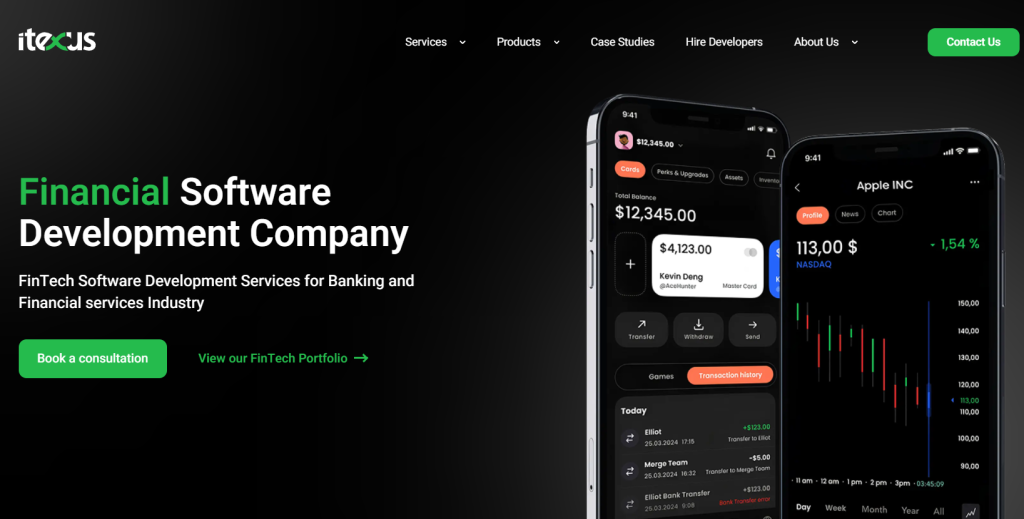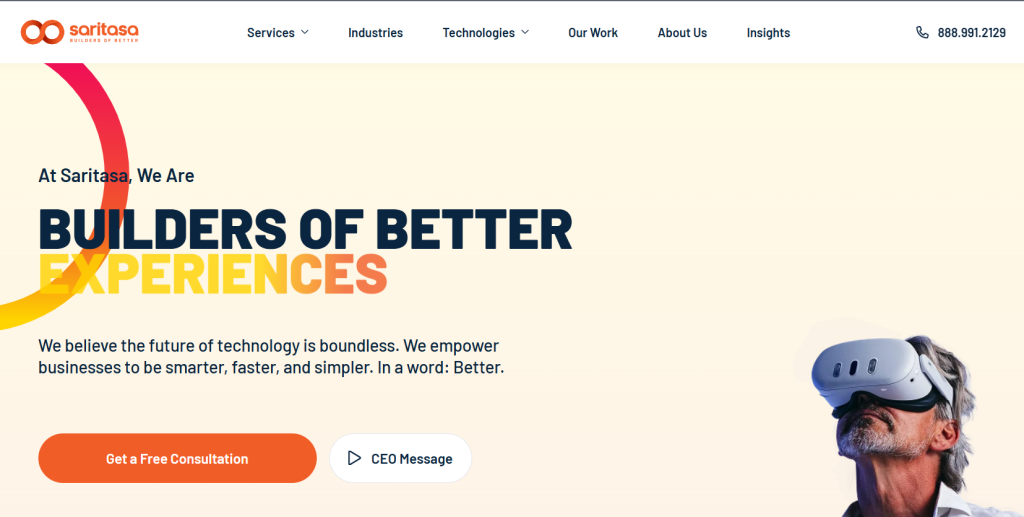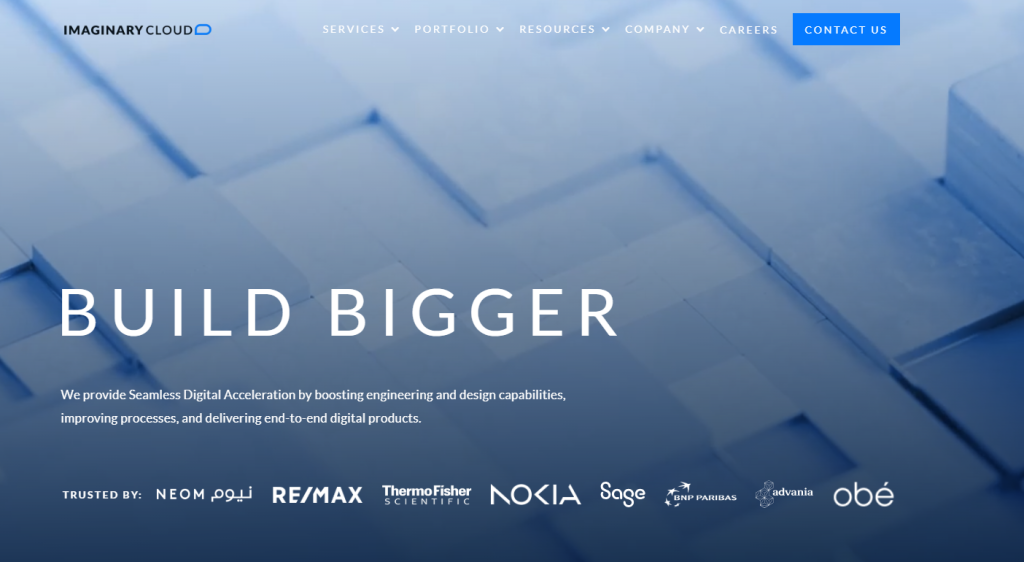The average cost of a custom FinTech product ranges from $90,000 to $300,000, depending on scope and complexity. Factors that affect cost include system architecture, security requirements, compliance frameworks, design scope, and the development team’s location. MVPs and prototypes cost less, but large-scale platforms with third-party integrations and strict regulatory controls are more expensive.
Top FinTech software development companies: The core of modern finance

Mykhaylo Terentyak
Author

November 12, 2025
Date

 33 minutes read
33 minutes read
Content
Over the past decade, finance has moved from a system of vaults, branches, and paper trails into a digital organism. Money now moves through invisible channels, and the code behind it decides who gets paid, when, and under what rules. At the center of these processes stand FinTech software development companies. They are the architects of a modern financial world.
The industry’s growth speaks for itself. Global FinTech revenues are projected to reach $1.5 trillion by 2030 – up from just over $250 billion in 2023. However, with new opportunities emerge new challenges, technical and regulatory. Therefore, for financial institutions and start-ups alike, choosing the right development partner has become one of the most decisive factors in long-term viability and success.
This guide explores what sets FinTech software development services apart, how to identify the right partner, which FinTech app development companies are leading the market in 2025 and will be worth attention next year, and the trends, from AI and blockchain to cloud-native architectures.
Understanding custom FinTech software
Over the past decade, finance has become one of the world’s most ambitious technology labs. Payments now settle in seconds, and investing is available for everyone through the mobile app. Even small lenders now operate with the kind of data intelligence that global banks could only dream about a generation ago. All this happened because software became the engine of modern finance.
FinTech custom software development is one of the biggest hypes in the tech world. It’s about rethinking how money moves, how risk is evaluated, how customers experience financial services, and how institutions navigate a growing web of regulations. It’s the quality of the software that determines the relevance in the market for financial companies, from startups to established financial institutions.
This article is the result of our analysis of the modern custom FinTech software development services, the market of FinTech products, and the nuances of the industry. We’ve also examined the development decisions and the technology choices that drive the field. After reading, you’ll have clear understanding of what technical partnership in FinTech is and why it’s one of the most important strategic decisions for you financial business.
Why specialized development matters
The critical need for FinTech expertise
Building a social app or retail platform is one thing. Building a product that manages people’s money in real time, under global scrutiny, is entirely different. The systems behind digital banks, trading platforms, and payment gateways must run continuously, comply with standards and regulations, and maintain the highest security levels. A tiny misstep can freeze hundreds and thousands of transactions or expose sensitive data.
That’s why FinTech demands specific teams. Those experts must have a good understanding of how financial systems operate in calm and stormy situations. Developers need fluency in subjects most engineers never touch: liquidity management, settlement cycles, transaction reconciliation, data residency laws, and audit trails. They must know how to design products that comply with regulations before a regulator even asks. Such a combination of technical and financial intelligence makes specialized FinTech teams so valuable and rare.
Bridging innovation and regulation
FinTech is all about innovation. Fast payments, smart credit scoring, easy international transfers – we have access to these digital financial benefits from our smartphones. Yet there is a financial law that can’t be neglected. A new mobile banking feature may simplify user onboarding, but if it violates KYC (Know Your Customer) requirements, it can trigger regulatory action. A data-driven lending algorithm might improve approval accuracy but must still comply with fairness and transparency rules.
The most successful FinTech developers design with regulation in mind throughout the entire process. They embed automated checks, real-time monitoring, and encryption standards directly into the system to architect and deliver the product that can scale globally without constant redesigns or compliance crises.
Why do you need this guide?
This article was written for founders, CIOs, and product leaders who know that technology is at the core of the financial experience. It outlines how FinTech software is built today and how to choose the right partner to build it.
We’ll break down the anatomy of modern FinTech systems, examine the companies setting the standard in 2025, and explain the real cost and long-term value of custom solutions. This guide aims to help you make better, faster, and more confident decisions.
What does strategic partnership mean in FinTech?
When choosing a partner providing FinTech software development services you determine whether your product will turn into a trusted tool or become another bold idea abandoned after a couple of months. It’s fair for any field.
What’s specific for finance is the speed the industry changes and evolves, and tight regulatory boundaries. Companies just can’t rely on improvisation or generic outsourcing models; they need more than a vendor – a partner understanding the mechanics of financial systems. Moreover, this partner should be able to translate those demands and statements into software.
Such collaboration is closer to co-building than contracting. It’s based on conversations about user behavior, regulatory expectations, market timing, operational constraints, and the financial logic behind every feature. When done well, such a partnership gives FinTech teams something rare for this turbulent industry – continuity. A product can grow, adapt to new regulations, scale, enter new markets, and integrate new technologies while remaining stable.
Key trends and technologies in FinTech development
The digital economy now runs on invisible systems that move money at a speed hard to imagine. What used to be back-office infrastructure a few years ago has become the core of entire business models. FinTech platforms now handle everything from biometric verification to instant payments, and the tools powering them are evolving at a similarly rapid pace.
Why does FinTech need next-gen development?
According to recent industry data, the global FinTech market was valued at roughly USD 340 billion in 2024. It is projected to surpass USD 1.1 trillion by 2032, growing at a compound annual rate of about 16%. Such a growth creates enormous pressure on software development.
Traditional bank back-ends and point solutions simply can’t keep pace with the speed, regulatory complexity, and global reach that modern FinTech demands. Developers must now build systems that manage millions of transactions, process real-time data, integrate with third-party services, and comply with regulations across jurisdictions. The regions that haven’t traditionally been considered FinTech localization areas are now becoming major growth engines. In Latin America, the number of FinTech start-ups rose from around 700 in 2017 to over 3,000 by 2023.
Such a state of affairs calls for a next-generation FinTech app development – a business imperative that helps financial companies lead instead of following.

The pillars of FinTech software
Cloud-native architecture and microservices
Financial products are built in fragments – small, independent services that communicate over the cloud. Each part handles a specific task: one might process a payment, another confirms identity, and a third might monitor for suspicious activity.
This design philosophy makes it possible to update or expand a product without interrupting the rest of the system. A team can refine a lending algorithm or add support for a new region without pulling the entire service offline. The largest digital banks operate this way, their infrastructures stretched across multiple cloud providers so that even a local outage doesn’t interrupt customer access.
A security framework
When software handles capital, security has to be at its heart. Every transaction passes through layers of encryption; every database connection, API call, or user session is checked, logged, and verified. To meet the highest security standards, developers now work under a so-called “zero-trust” model. It means that no device, user, or system can be considered safe until proven otherwise. Regulations like PSD2 and GDPR have only reinforced this mindset, making strong security a non-negotiable requirement.
APIs network
Almost every modern FinTech app includes the entire web of connections. Payments, credit checks, analytics dashboards, etc rely on APIs. Those services allow a digital bank to confirm a customer’s identity through one service, move money through another, and issue a virtual card from a third.
This shift started moving at even greater speed after the Open Banking movement. Financial institutions made their data available in standardized, secure formats, and developers quickly began to build on top of those interfaces. Thanks to this, top fintech software companies can embed financial capabilities literally anywhere.
What FinTech software development services are there?
FinTech products usually look very simple on the surface and feel effortless to the user. But behind that simplicity lies an system of risk checks, compliance logic, encrypted communication, real-time data processing, and integrations with institutions that still run on outdated infrastructure. It’s not enough to be tech-savvy and creative to build financial software. FinTech custom software development requires engineering discipline along with an understanding of how money flows through systems, including digital ones.
Modern FinTech development demands a clear strategy for integrating with payment processors, core banking APIs, credit bureaus, trading engines, messaging services, and every other component required to keep financial products running in the real world. In this ecosystem, FinTech software development services fall into several categories: digital banking, payments, wealth management, lending, and regulatory technology. Each category has its own architectural needs and operational challenges.
Digital banking & Payments
Digital banking is now one of the most ambitious FinTech app development services. Creating these platforms requires systems that can verify identities, handle KYC and AML checks, store personal data, and process payments across multiple currencies and networks in real time while remaining intuitive and user-friendly. The work behind the scenes often involves connecting cloud-native services with traditional banking rails and ensuring that even under heavy load, transactions remain accurate and audit-ready. When done well, the result is a banking experience that feels effortless, even though the machinery supporting it is simple.
WealthTech & Investment platforms
Investment technology has undergone one of the fastest transformations in finance, expanding access to markets once limited to professional traders. Behind a sleek trading or portfolio-management interface lies a complex interplay of data feeds, risk models, regulatory requirements, and user-personalization engines. Developers operating in FinTech custom software development must design systems capable of managing real-time market data, executing trades correctly, recording every action for compliance purposes, and delivering insights without overwhelming users.
Lending & Credit solutions
The lending world is now almost completely automated. Loan applications that used to take days can now be processed in minutes thanks to digital forms, algorithmic decisioning, and automated identity checks. The development of these systems became possible with robust data pipelines, reliable integrations with credit bureaus, and scoring engines that balance accuracy with fairness. It also demands that workflows keep applicants informed, regulators satisfied, and lenders protected from fraud. A well-engineered lending platform combines all of this to create a smooth experience for all parties involved.
Regulatory technology & Security
RegTech is a sector of software development services for FinTech that helps companies navigate a regulatory world. They automate compliance reporting, risk monitoring, identity verification, and fraud detection. Building RegTech software calls for an unusual combination of legal understanding and technical expertise. Systems must interpret rules correctly, store sensitive data securely, and produce records that withstand audits. In many cases, these tools become the silent backbone of financial operations, monitoring activity and spotting issues before they become problems.
Latest financial technologies
New areas such as decentralized finance and InsurTech continue to broaden the possibilities of FinTech software development services. DeFi protocols introduce entirely new architectures based on smart contracts and blockchain networks. They demand airtight security and clear logic around asset flows. InsurTech platforms, on the other hand, focus on automating underwriting, claims processing, and risk assessment. This is where AI models are of a huge help.

New wave of FinTech and the technologies driving it
Artificial Intelligence and Machine Learning
As it is with most fast-developing industries, the next decade of FinTech will be all about intelligence, or, to be more precise, — artificial intelligence. Machine learning quietly won its place behind most of the FinTech experiences today. It predicts frauds, automates credit checks, and provides custom investment recommendations to each individual user.
This shift looks even more promising with a constantly glowing level of sophistication of these systems. They learn and ingest millions of data points such as transactions, interactions, external signals, and refine themselves incredibly quickly. When used wisely, these resources give users smoother experiences without the feeling of being overwatched by a machine.
Blockchain and decentralized finance
A term blockchain used to be tied predominantly to cryptocurrencies. However, it can be confidently named a framework for trust. Distributed ledgers now record payments, ownership transfers, and lending agreements with transparency that centralized systems have always struggled to match. Even traditional banks have taken notice. The technology is not replacing existing systems, but its influence is changing how developers think about verification, traceability, and shared record-keeping.
Embedded finance
In the meantime, while the abovementioned technologies have been lively discussed, the most transformative one has quietly become a vital part of everyday operations. Financial tools are being built directly into shopping apps, logistics portals, ride-hailing and food delivery services.
This model, known as embedded finance, blurs the boundary between financial services and every other digital experience. It demands form developers to build infrastructure flexible enough to live behind another company’s interface while still meeting all regulatory and security requirements. This is a prominent example of how something that used to be a standalone financial product is now a background function supporting an entirely different industry.
Choosing a FinTech development partner
Finding a team to build financial software is like choosing a co-founder. The partnership will define your product’s direction, your ability to adopt innovation, and your ability to adapt to regulations. Needless to say, those are the things that form your firm’s reputation, as finance is the field where mistakes are not easily forgiven and forgotten.
Criteria to check
The compliance track record
A capable FinTech partner should be able to show how they’ve met industry regulations in the past. You want evidence of systems built under frameworks such as PSD2, GDPR, SOC 2, and PCI DSS, because each leaves a trail of technical decisions: data-retention rules, encryption policies, logging standards, and access-control logic. Teams with experience in these environments understand that a seemingly simple design choice (say, how user data is cached) can have legal consequences.
Solutions in the portfolio that resemble yours
If the vendor’s past work includes mobile banks, payment gateways, or investment tools, they’ve already faced many of the challenges your project will (potentially) encounter. Examine how those products behave under load, how their interfaces handle complex actions without confusion, and whether they scale gracefully. In FinTech, precision and predictability under pressure are considered a genuine elegance.
Stack alignment
Not all stacks are created equal for financial workloads. Some teams specialize in high-volume transaction systems written in Java or .NET; others excel at cloud-native platforms in Node.js or Python. Examine how the team’s technical preferences align with your product’s needs. A good partner will be able to explain, in plain language, how a specific database choice improves auditability or how containerized deployment reduces downtime.
Operational excellence and standards that define it
Commitment to performance and growth
FinTech products have a tendency to grow faster than expected. One viral feature, a new partnership, or a marketing activity can multiply user numbers overnight. A serious development partner anticipates these cases from day one. They build systems that handle spikes without failure and test under stress before customers ever arrive.
Agile process and delivery speed
When practiced well, Agile methodologies balance speed and productivity. They break complex goals into iterative chunks and allow you to see progress early and adjust. In the area where regulations can change mid-project, this flexibility is crucial. If financial app development companies conduct regular demos, sprint reviews, and transparent progress tracking practices, they are truly interested in keeping everyone aligned and preventing last-minute surprises.
Communication approach and engagement models
Financial software development is complex enough; communication shouldn’t add to this complexity. Look for financial app development companies that set expectations early: who handles decisions, how feedback cycles work, how they track budgets and hours, etc. Some clients prefer dedicated teams that operate as an in-house extension, while others choose fixed-price contracts for well-defined scopes.
When collaboration works, it feels like a single team moving in sync. Designers, engineers, and product leads speak the same language, understand who does what, and deliver what is expected and when it is expected.
Top FinTech app development companies: USA and Europe
After learning what to expect, let’s continue with the list of companies that meet each criterion. Below are 10 FinTech app development companies that stand out for their commitment to both engineering and regulatory readiness.

Blackthorn Vision
Based in Eastern Europe and operating in the US, the UK, and Europe, Blackthorn Vision has built a reputation for long-term software partnerships across sectors, including FinTech. Over 100 completed projects, Fortune 500 clients, Microsoft Gold Partner status, and top finance app developers are among its credentials. In the financial field, it emphasizes end-to-end product development, combining cloud migration, data-intensive analytics, and startup-grade agility.

10Clouds
10Clouds, headquartered in Warsaw, presents itself among FinTech software development companies and banking specialists within a broader software-house framework. Their website showcases mobile banking apps, AI-powered identity tools, and blockchain products built for financial clients. In particular, they emphasize secure, mobile-first application development in FinTech markets.

Praxent
Based in Austin, Praxent focuses on digital transformation for financial firms, bridging legacy systems with modern architectures. Their delivery model often centers on turning established financial processes into API-enabled, cloud-native services. While not exclusively FinTech, their experience in banking software modernization positions them as a strong contender for institutions seeking to move beyond traditional monoliths.

KindGeek
KindGeek operates as a full-service product partner, notable for its focus on advanced financial technology. Their portfolio includes wallet development, blockchain-enabled platforms, and financial start-ups, rather than purely legacy-banking modernization. For companies treating FinTech as a “new frontier”, KindGeek offers a blend of product design and emerging-tech delivery.

Itexus
Itexus banking app developers modernize applications and provide API-enabled services in regulated markets. Their strength lies in enabling financial clients, including banks and lenders, to transform older architectures into data-driven platforms. This makes Itexus a strong option for conservative financial institutions seeking a partner skilled at large-scale modernization.

Saritasa
Saritasa is a U.S.-based development firm that spans enterprise and FinTech work, specifically in cloud-enabled payment systems, loyalty programmes, and financial-cloud applications. Their dual focus on mid-sized incumbents and start-ups offers flexibility, useful for companies looking to launch new financial services while retaining operational robustness.

Miquido
Poland-based Miquido is best known for strong UX/UI and mobile-app delivery, and its clientele includes FinTech products where customer experience is as essential as backend scale. For brands where front-end engagement, including user onboarding, mobile banking flows, and app loyalty is the differentiator, Miquido stands out.

Geniusee
Geniusee, headquartered in Ukraine, focuses on digital banking, blockchain, and AI-driven finance solutions. Their experience spans both start-ups and institutional clients, with a focus on novel FinTech services. This positioning makes them a fit for companies building next-generation financial platforms rather than legacy replacements.

IntellectSoft
IntellectSoft serves primarily enterprise-scale financial clients, including banks, asset managers, and insurers. It builds custom FinTech platforms ready to be scaled and integrated, meeting all compliance criteria. Their strength lies in large systems with high regulatory burden, where the partner must deliver not just features but also trust, auditability, and resilience.

Imaginary Cloud
Last but not least, Imaginary Cloud. Based in Lisbon, this company blends product design, front-end polish, and reliable FinTech engineering. While smaller than some enterprise players, they have a strong niche in embedded finance or financial services integrated into consumer platforms, where user experience and brand feel are primary differentiators.
| Company | Strengths | Best for |
| Blackthorn Vision | Known for data-intensive systems and end-to-end product development. Work often involves analytics, automation, and compliance-driven infrastructure. | Companies of all sizes looking for a long-term partner capable of building secure, scalable platforms from the ground up. |
| 10Clouds | Blends sharp design with serious backend engineering. Experienced in blockchain, mobile banking, and identity verification tools. | Start-ups or scale-ups that need mobile-first apps combining usability, performance, and strong security foundations. |
| Praxent | Focused on digital transformation for established financial institutions. Skilled in re-architecting legacy systems while keeping operations intact. | Banks or lenders seeking to modernize their systems without halting ongoing business. |
| KindGeek | Agile product development paired with a solid grasp of emerging financial technologies. Strong background in wallets, lending, and neobanking. | Early-stage FinTech firms that need rapid prototyping and an adaptable team to evolve with their market. |
| Itexus | Deep backend expertise and a proven ability to handle regulated environments. Prioritizes compliance and stability in every release. | Enterprises migrating old banking or lending platforms into more flexible, API-driven ecosystems. |
| Saritasa | Solid engineering processes, cloud fluency, and cross-platform experience. Balances reliability with business agility. | Mid-sized companies expanding payment systems or integrating new financial services into existing apps. |
| Miquido | One of Europe’s strongest UI/UX teams paired with technically reliable execution. Delivers products that feel intuitive without sacrificing precision. | FinTech products where customer trust and digital experience are central to growth. |
| Geniusee | Combines innovation in AI and blockchain with practical delivery for financial institutions. Flexible structure suited to different engagement models. | Ambitious start-ups building next-gen finance tools such as digital banks or tokenized platforms. |
| IntellectSoft | Long-standing enterprise developer with deep security credentials and system-integration expertise. | Large financial organizations requiring enterprise-grade solutions that meet strict audit and compliance standards. |
| Imaginary Cloud | Design-first studio delivering refined interfaces and stable backends. Particularly strong in embedded-finance projects. | Consumer-oriented businesses embedding payments, credit, or insurance into non-financial platforms. |
How to define cost and value in FinTech software development
The money flowing into FinTech rests on very real engineering work. This includes months of product design, architecture planning, security hardening, and relentless testing. Understanding what drives the price of this effort and what to expect in return is essential before you commit to a development partner and sign a contract.
Industry analyses consistently show two trends. On the one side, global FinTech revenues are constantly growing. On the other side, development capacity is under pressure and specialist teams remain in high demand. Hourly rates vary depending on the region and expertise, but are steadily growing. In 2024–2025, typical software development rates range from about $20–$60 per hour in Asia to $100–$170 per hour in North America, with Eastern Europe often sitting in the $30–$80 per hour band.
That gap alone can double or halve a project’s budget. Therefore, let’s look at what, apart from geography, forms the price and the value of FinTech software development.
Understanding the investment
Most credible estimates place the development cost of a FinTech application somewhere between $90,000 and $300,000+, depending on scope and complexity. Simpler tools, such as lean personal finance apps or single-purpose wallets, can fall at the lower end of that range. Data-heavy investment platforms, lending systems with automated decisioning, or multi-region banking apps sit higher.
To get a sense of scale, some industry breakdowns suggest rough bands by category:
- digital banking apps: from around $30,000 to $100,000 for a basic version,
- lending products: roughly $50,000 to $150,000,
- investment platforms: often starting near $100,000 and climbing as features expand.
Those figures reflect a simple truth: two products with similar functionality on the surface can cost very different sums to build, depending on architecture, integration depth, and regulatory expectations.
Factors that create development cost
- Scope and complexity. A basic MVP that allows user registration, balance tracking and simple transfers is a different undertaking from a platform that handles multi-currency accounts, risk scoring, dashboards, and partner integrations.
- Security and compliance expectations. Strong encryption, fine-grained access-control, audit trail implementation and regulatory reporting add significant engineering effort, especially for products subject to PSD2, GDPR, CCPA, AML/KYC and sector-specific rules.
- Third-party integrations. Connecting to payment gateways, Open Banking APIs, credit bureaus, trading engines, KYC providers, or core banking systems requires careful design and testing. Every integration carries both technical and contractual overhead.
- Design depth. FinTech users rarely tolerate confusing flows. Thoughtful UX for onboarding, verification, transaction review, and dispute handling can consume a meaningful portion of the budget.
- Team location and seniority. As mentioned, hourly rates differ dramatically by geography. North American or Western European teams sit at the higher end. At the same time, nearshore and offshore regions can reduce total cost by 40-60% without necessarily sacrificing quality, provided the partner is carefully vetted.
The ROI of building a tailored system
The next question is – is it worth it? Do you actually need this custom solution? The quick answer is – yes. Off-the-shelf products may look cheaper on paper, but they often lock you into a rigid feature set, limit differentiation, and force your processes to adapt to someone else’s logic. License fees accumulate, customization remains constrained, and integration with legacy systems can be highly complex.
Custom FinTech software offers a different type of return:
- It reflects your own risk models, underwriting rules, or investment strategies.
- It can be designed to meet the exact regulatory regimes you operate under, rather than the broadest common denominator.
- It creates an asset that sits on your balance sheet and can appreciate in value as the business grows.
ROI often shows up in less obvious places, too: reduced manual processing, fewer compliance incidents, lower fraud losses, improved customer retention, and better unit economics per user or transaction. Over a three-to-five-year horizon, these gains usually outweigh the initial build cost.
Maintenance and growth
One of the most common miscalculations in FinTech budgeting is treating launch as the end of the cost curve, when, in fact, it marks the beginning of the new phase. Regulations change, fraud patterns evolve, and users push the system in ways nobody predicted during testing. Competitors roll out features that completely reset expectations and create new business challenges. Analytics becomes richer, and new technologies appear. A platform built today has to adapt continuously to stay relevant.
From a practical standpoint, this means setting aside budget for:
- Ongoing security updates and patching, especially as new vulnerabilities arise.
- Performance tuning, as user numbers and transaction volumes rise.
- Feature expansion, based on customer feedback or market changes.
- Regulatory updates, such as adjustments for new data protection rules or local licensing conditions.
Many organizations choose to keep a smaller version of the original development team engaged under a support-and-evolution agreement. That continuity pays off, because the people who understand the system’s foundations can extend it without creating fragile workarounds.
What defines a reliable FinTech software development partner?
What has set successful FinTech app development teams apart is the ability to understand the financial logic behind the product – the decisions and constraints that define how the system must behave in the real world. Teams with deep FinTech experience can identify patterns that could create bottlenecks months later. They anticipate compliance requirements before auditors raise questions. When adding a new feature, they know how it will affect transaction speed, risk monitoring, user verification, or data governance.
FinTech companies also choose partners who treat security as the priority. There were numerous breaches, compliance failures, and outages over the last decade that called for new regulations and their timely updates. Teams that embed encryption, access controls, auditing, and continuous scanning into everyday workflows help companies be more innovative and trustworthy.
Security, compliance, and DevSecOps
If a platform mishandles data, fails an audit, or suffers an outage during peak activity, trust disappears. This is why security and compliance must be at the core of almost every architectural and operational decision of the company offering FinTech app development services. Strong systems begin with secure foundations: encrypted communication, strict identity management, hardened APIs, and infrastructure designed to withstand both expected traffic and unexpected threats.
DevSecOps makes this security posture practical. Instead of relying on periodic audits, every stage of FinTech app development is infused with automated checks, code scanning, dependency monitoring, and controlled deployments. This approach reduces human error and allows teams to ship updates quickly without introducing new vulnerabilities. For financial institutions facing pressure from PSD2, GDPR, CCPA, SOC 2, and a changing global compliance landscape, this continuous protection is essential.
AI/ML integration
Transaction histories and data points can hide numerous fraud signals. To detect them, a FinTech development company can apply AI. These systems help to interpret patterns incredibly effectively and nearly instantly, and reduce manual processes.
In lending, machine-learning models help assess risk, considering all the nuances. In payments, anomaly detection tools catch fraudulent activity. In wealth management, algorithms shape portfolios based on user preferences, market conditions, and risk profiles. To get the most from AI integrations, a company providing FinTech application development services must know how to maintain data quality, model transparency, and face regulatory constraints.
Enterprise-grade and cloud-native architecture
In current situation, the product that started from a thousand users might grow to a million of users withing a year. Systems built on monolithic or outdated architectures usually can’t stend such growth and collapse. The solution lies within cloud-native development. It allows systems to scale horizontally and recover quickly from failures. Microservices, containerization, and event-driven architectures help individual components remain stable even under heavy demand. This design also allows FinTech app development services providers update parts of the system individually.
Faster time-to-market
Speed is a defining factor in FinTech. Markets shift quickly, and competitors roll out new features more frequently. A partnership with a strong FinTech development company helps validate ideas fast, iterate with confidence, and release updates rapidly. They integrate directly with internal teams, reduce friction between product and engineering, and help move features from concept to deployment without delays. This collaborative rhythm allows FinTech companies to stay ahead of trends, pivot when needed, and respond to regulatory changes without derailing their roadmap.
Our FinTech software development process
At our FinTech software development company, everyone involved in the development process must have a clear view of how the product is taking shape and the trade-offs being made along the way. Keeping everyone informed and up to date is vital to us. This approach also creates the kind of discipline financial software demands: documented assumptions, predictable timelines, and a shared understanding of why the system is built the way it is. Here’s a step-by-step description of our development process.
Step 1: Discovery and roadmapping
At the beginning of every project, our teams explore the product’s purpose, the markets it will enter, and the regulations it must comply with. This phase involves conversations, workshops, architectural sketches, and the careful mapping of compliance requirements, including KYC, AML, PSD2, and local data governance rules. By the end of discovery, the team knows what they are building, how to behave, why, and how it will fit into the larger financial ecosystem.
Step 2: Architecture design and prototyping
Once the direction is clear, the FinTech development company’s architects define the backend architecture, data flows, integrations, and the cloud environment. Prototypes and early interface designs help validate the user experience and ensure that regulatory obligations are reflected in the product’s core workflows. This stage prevents costly mistakes later and gives everyone a tangible sense of the product before full development begins.
Step 3: Development
The development process moves in small, focused steps. Each iteration includes coding, testing, security reviews, and feedback loops. Because FinTech cannot afford security gaps, automated scans, secure build pipelines, and continuous monitoring run throughout the process. Regular demos help product teams refine features early, avoiding the long rewrites that often derail financial projects.
Step 4: Launch and QA
Before launch, the platform undergoes a series of tests: load testing to simulate peak traffic, penetration testing to identify vulnerabilities, and compliance checks to ensure the system meets all regulatory requirements. After release, a warranty period keeps the development team involved and helps stabilize the platform in its real-world environment. This final phase gives companies confidence that there won’t be unexpected failures.
Tech stack behind FinTech software development services
The technical stack is what determines how quickly a platform can scale, how securely it can store sensitive information, how easily it can integrate with external services, and how efficiently teams can release new features.
Most financial platforms rely on languages that can process high-volume transactions without losing precision or speed. The systems must be engineered to handle complex workflows, from reconciling payment data to calculating risk scores. On the front end, modern frameworks such as React or Angular help create user interfaces that feel fast and intuitive, even when they sit on top of dense financial logic.
When it comes to databases, SQL systems support auditability and transactional consistency, while modern document stores or in-memory databases help with performance-heavy workloads. For products operating in real time (trading platforms, fraud detection tools, instant-payment systems, etc), streaming technologies and event-driven architectures ensure information moves through the system without delay.
Cloud platforms such as AWS, Azure, and Google Cloud are now standard for finance firms. These environments offer security layers and global availability zones that keep services running even when traffic surges or regional outages occur. Docker and Kubernetes allow teams to deploy updates safely and scale systems automatically when demand rises.
Newer technologies also play a growing role. Machine-learning frameworks support predictive features in lending and fraud detection. Blockchain tools underpin digital-asset products or decentralized protocols. And identity-management systems help financial products meet strict authentication standards.
Resources for strategic leaders
For founders, CTOs, or innovation leads, it’s important to understand the nuances of the field they are operating in. This knowledge helps them better understand their users and partners and formulate ideas clearly. They also want the latest data to be prepared to shifts and updates, considering the dynamic field. From another angle, they need inspiration.
One of the most comprehensive perspectives available comes from the Cambridge Centre for Alternative Finance and the World Economic Forum, whose global FinTech report tracks everything from sustainable growth strategies to regional adoption patterns. Their latest edition shows how FinTech firms are moving beyond rapid customer acquisition and investing heavily in financial inclusion and operational resilience.
Another valuable resource is the FinTech Leaders Report published by CeFPro and distributed via FinTech Futures. It examines the priorities of executives around the world: cybersecurity pressure points, risk-management frameworks, and the technologies gaining the most traction in regulated markets. For companies preparing for audits or designing compliance-first platforms, this report offers a realistic benchmark rather than abstract theory.
The Juniper Research “Future of FinTech” whitepaper (though published a few years ago) remains a reference point for understanding the early signals that shaped today’s financial-technology landscape. Many predictions that seemed ambitious at the time have since materialized, offering context for how current innovations may evolve.
The FinTech Alliance Knowledge Bank provides open-access papers on cloud-banking architectures, decentralized finance, regulatory technology, AI adoption, and consumer protection. For teams preparing to redesign legacy systems or enter new markets, these resources help frame questions that might otherwise go months unanswered.
Choosing a strategic FinTech development partner
FinTech has evolved into one of the most demanding fields in modern custom software development services. Its product must combine the speed of a startup and the scalability and reliability of an established firm. It must look simple to the user, while managing enormous complexity behind the scenes. And above all, it must earn trust – from customers, regulators, and partners.
What defines successful FinTech development today is an understanding of how financial systems behave under pressure and how they must be engineered to withstand it. It’s the ability to move quickly without vulnerabilities, to design architectures that can grow without collapsing under their own weight, and to interpret regulations in a way that supports the product rather than slows it down.
For companies building digital banks, lending platforms, investment tools, or entirely new financial systems, the development partner they choose becomes part of their long-term strategy. A good partner helps shape the product and ensures it has a future by scaling, updating, polishing, etc. If you’re looking for such a FinTech software development company, you’re at the right place. Contact us to discuss a technical partnership.
In conclusion
The financial world has entered a stage where technology defines business. Every interaction, every risk assessment, every transfer of value now runs through lines of code written by teams who must understand both engineering and finance. Choosing a FinTech development partner, therefore, is a strategic decision about how your company will evolve in a digital economy.
Whether you’re beginning that journey or have been navigating this landscape for some time, contact us for consultation or technical partnership. We are here to develop custom solutions that will bring you to market quickly and win you loyalty and reputation.
FAQ
How much does it cost to develop a custom FinTech application?
What documentation and intellectual property rights do you provide after project completion?
Like all responsible finance software development companies, we send you complete ownership of all source code, documentation, designs, and deployment assets. Intellectual Property (IP) rights will be explicitly transferred in the final agreement, so that the product remains under your legal control. We also provide post-delivery warranties that cover bug fixes and compliance updates.
What engagement models do you offer?
For financial services app development, we provide several formats: dedicated teams for continuous collaboration, staff augmentation to complement in-house capabilities, and fixed-price projects for clearly defined scopes or short-term cooperation. The choice is up to you and depends on your internal resources, project complexity, regulatory oversight, and timeframes.
How do you incorporate AI and blockchain into FinTech products?
We use machine learning models as a new standard in fraud detection, credit scoring, and personalized investment advice. Blockchain, meanwhile, supports transparent transaction records, smart contracts, and cross-border payment systems. The best fintech app developers combine these technologies with traditional infrastructure to keep a balance between innovation and compliance.
What post-launch support options do you offer?
As a technical partner interested in our client’s longevity and success, we offer continuous maintenance, monitoring, and feature evolution for 6-12 months after launch. Long-term scalability planning, including cloud optimization and load testing, is a vital part of our initial roadmaps.
Can you integrate a new FinTech platform with existing systems?
Yes, however, integration is one of the most challenging aspects for financial software development companies. Legacy systems often lack modern APIs or consistent data structures. Our FinTech application developers handle this through middleware layers, secure API gateways, and data normalization processes that allow real-time communication between old and new systems.
How long does it take to develop an MVP for FinTech?
A functional MVP, such as a digital wallet or neobank prototype, typically takes finance software development companies four to six months to design, develop, and launch. Highly regulated products or multi-country deployments can stretch closer to a year. Choose teams that align to an agile methodology; they deliver faster and the chance of mistakes is close to zero.
What are the benefits of a cloud-native architecture?
Cloud-native architectures enable applications to scale smoothly and recover automatically from failures. Microservices separate complex financial operations, like payments, KYC, and risk management, into smaller modules that can be updated independently. This approach shortens release cycles and simplifies compliance updates when regulations change.
How do you ensure security and data protection?
Our teams apply a zero-trust model, encrypt all sensitive data at rest and in transit, and implement role-based access control. Continuous penetration testing and automated vulnerability scans are standard practice at Blackthorn Vision.
What compliance standards should a FinTech development company guarantee?
Finance software development companies should demonstrate experience with PSD2, GDPR, and AML/KYC standards. For financial products operating in North America, CCPA and SOC 2 Type II are also critical. Projects involving payment processing must comply with PCI DSS, while institutions managing customer deposits may require adherence to ISO/IEC 27001.




































































